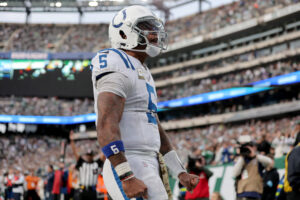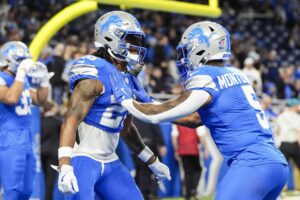Turnovers and field goals are the magic potion which heals all wounds for the Kansas City Chiefs. Despite executing plays that were tangentially questionable, allowing 5.27 yards per carry, Alex Smith being irregularly inaccurate (45 percent completion percentage), the run game only creating 2.1 yards per carry, and kicking only field goals in the second half, the Chiefs managed a 29-19 dominating victory over the Denver Broncos. The Chiefs progressed, regressed, and then fell asleep after a long week off. Harrison Butker was the exception, kicking five field goals to ice the game. The victory was reminiscent of years past when the Chiefs had to rely on field goals and bouncing turnovers to put them over the edge. Fortunately, the Broncos were rather unimpressive on offense themselves. The Chiefs week eight stats were up, down, and a mixture of anomalies that resulted in a win, and a win is the most important stat on the end board.
Kansas City Chiefs Week Eight Stats and Charts – The Kansas City Field Goals
Chaos Theory
The model of chaos was straightforward for the Chiefs in their 29-19 victory. At no point did the Broncos have control, or any essence of control. The Chiefs did their job in killing the Broncos offensive will on the second drive when Marcus Peters ripped the ball from Jamaal Charles and returned it 45 yards for the first six points of the game.
Arrowhead Stadium provided an overwhelming home field advantage from kickoff. After two punts by both teams, then the fumble return, the Chiefs asserted chaos. And it was the chaos they crafted through turnovers which enabled a victory.
Typically, when a team can run and control the clock, they will win. The Broncos did so, averaging 5.27 yards per carry. Even the run which Peters tore the ball from Charles was moving forward. However, the Broncos offense failed to generate points from running efficiency due to a travesty of a passing game. Despite owning the ball for 31 minutes compared to the Chiefs 28, Trevor Siemian was sacked three times, and threw three interceptions.
The point at hand for chaos theory, was the Chiefs defense returned to form in high leverage situations. The defense and special teams gave the Chiefs excellent field position to fight for their first offensive touchdown to go up 14-0. Peters’ subsequent and first interception ought to have killed the Broncos momentum, minus a questionable play call from Andy Reid.
In the model of chaos and control, Reid offered a helping hand to the Broncos by letting Tyreek Hill attempt a pass to Ross Travis – the pass was a glorified wounded duck, and thus intercepted by Darian Stewart. This was the sole change in the game’s momentum. Before this point Kareem Hunt went on a 15-yard scurry, and Travis Kelce had caught a 19-yard pass in the middle. Reid had effectively put the Broncos on their heels, spread them out, and removed the pass rush from the Broncos play book. Yet, it was all for naught when Reid got unusually cute.
There is taking calculated risks, throwing deep to Kelce on a good defense which has trouble covering tight ends, then there is unnecessary risk. When the opportunity to go up 21-0 is present, Reid ought to choose a high percentage play to achieve such merits. The play chosen was unnecessary risk. Even had Hill’s pass netted a gain, the mere potential of the shift in momentum due to everything that might go wrong made it an awful play call.
Momentum certainly did shift. The Broncos marched up field to kick a field goal, but a field goal that could have been a touchdown if offensive coordinator Mike McCoy did not opt to submit a heavy passing attack. Fortunately for the Chiefs, the passing game played into their hands. A second quarter interception, a third quarter muffed punt, and then a fourth quarter interception sealed the Broncos fate.
The Chiefs may have attempted to roll over on offense and meander their way through the game, but in those highest leverage moments, special teams and defense came through to throw the Broncos further into chaos.
Return of the Patented Field Goal Machine
Since 2013, quarterbacks are 36-143 when throwing for a completion percentage under 50. Two of those wins have been on behalf of the Chiefs, one coming last night. Smith threw for a mere 44.16 completion percentage, tied for the lowest mark in his Chiefs tenure. The other win came against the Oakland Raiders in 2013 when he met the same 44.16 percent mark. Coincidentally, the loss came to the Broncos in the same year, when Smith completed 21 of 45 passes in a 27-17 letdown.
The notion at hand with the low passing mark is two-fold. First, the special teams for the Chiefs came through to put an emphasis on field position which marginalized the low completion percentage. Second, the Broncos defense worked their deception and created dysfunction in the Chiefs passing attack.
Addressing the special teams notion first, on five of the 14 drives, the Chiefs were able to start in Broncos territory, while only two drives started behind the Chiefs 20-yard line. The ability to start so far up field on an evening where the Chiefs offense was totally inept was a causation for victory.
The longest drive of the night was the 68-yard touchdown in the first quarter. While it should have been more, three of four second half field goals were created by drives that began in Broncos territory. Considering one of those drives saw a total net of negative two yards, the Chiefs may not have been able to win comfortably without the return unit and defense creating opportune field position.
(Note, this was not the punt return unit; not one punt was returned for any net gain).
Regarding those field goals, they were a return of the Chiefs operation from previous seasons as the ‘Kansas City field goals.’ Butker went 5/5, including three fourth quarter field goals over 40-yards (43, 51, and 42). Butker also completed five field goals without a miss in the game against the Houston Texans, joining 48 other kickers (since 1950) who have attempted five or more field goals, made all of those attempts, and have done so in multiple games.
However, the return to the Kansas City field goals was a major regression from the meta perspective, and serves as the second notion against the offense. Hunt failed to generate emphatic runs throughout the game, thus the normally effective passing formations could not realign the Broncos defense. The Broncos safeties and corners could efficiently shut down the Chiefs short targets in a game where the front line handled the run, enabling the safeties to play the second half without honoring run formations.
Hill, Charcandrick West, and Kelce caught passes in the short cones, but linebackers and safeties met them and secured safe tackles. Stats aside, the Broncos simply played with more aggression. Even in the run game, repetition did not work as Hunt garnered only eight attempts on 11 yards toward the typically successful interior gaps.
The failure was not on Reid’s play calling. He attempted to run the ball where success is usually derived. The short passes were attempted, and failed against a great defense. A pattern of field goals resulted then from the Broncos defense locking down those Chiefs high percentage plays on their half of the field. Just as leverage was asserted by the Chiefs defense, the Broncos executed even better, just without the turnovers.
The Chiefs converted just two of 12 third downs while acquiring 16 first downs. Despite the random success, the field position battle is the meta reason for a Chiefs victory.
When momentum was lost, Smith attempted to force nine deep passes, completing five. The line looked worse as all three to the deep right cone fell incomplete. The positive on the day was Kelce’s performance. He returned to form and executed his half of the gameplan. Kelce caught four deep targets for 100 yards and one touchdown. If Kelce can serve as the ever-reliant target for Smith in matchups where the full game plan aligns, then the Chiefs offense will return to the explosive machine it was in week one.
Return of the Patented Turnover Machine
Rivalry games bring about old habits. As true as that notion reigned for the field goal machine, it was also true for the notion of the turnover machine. The Chiefs forced a plethora of errors from the Broncos on Monday, and had they not asserted momentum thanks to the special teams unit, then the game would have looked drastically different. But, in the highest leverage situations, the Chiefs defense forced turnovers and erased passing lanes.
One of those turnovers came on a muffed punt return by Broncos Isaiah McKenzie. The ball was muffed on his own effort, but De’Anthony Thomas was right on point to recover the punt, leading to a field goal. Dave Toub’s special teams unit shined on several other data points. They kept the longest kick return to 21 yards, the longest punt return to three yards, and Dustin Colquitt consistently pinned the Broncos 41.8 yards downfield from the punt. Colquitt was truly the unannounced MVP of the night.
The other turnovers came on concentrated plays by Peters in the first quarter, then Ron Parker and Kenneth Acker came away with their own interceptions. The Chiefs defensive unit confused Siemian and lowered his tenured poor performance. Those turnovers resulted in the Chiefs forcing the Broncos to call conservative passes in the red zone. Even when touchdowns should have come, the Broncos merely drummed up a field goal. Without explosive plays coming in scoring situations, momentum remained in the Chiefs favor.
However, those explosive plays in the run game did come before the red zone, and could have scorched the Chiefs defense had the score not mentally forced the Broncos to insistently align pass. Derrick Johnson, Allen Bailey, Reggie Ragland – the entire middle of the alignment was egregious in run defense. Bennie Logan stood out with four run stops. In a position he usually absorbs the double team, he took the onus of tackles.
Johnson only managed three stops, Bailey two, and Ragland three. The Broncos tore down the middle wall for a total of 147 yards on 21 carries, enabling them to simply drone through the middle gap where all explosive plays were asserted. Elsewhere, the Broncos ran nine times for 16 yards. Take out two six-yard carries through the right guard, and that total is seven attempts for four yards.
A bad Chiefs run defense showed up again, and will continue to show up unless the interior plays with more aggressive intelligence. The Broncos ran one basic package toward the middle of the field, and the defense fell for it without thinking.
A lack of intelligence also came from behind center in Siemian’s passing attack. No matter the target, his throws were off, putting receivers in awful situations to catch efficiently. On 36 attempts, they only let short, dead on arrival passes, fall complete. Despite 12 different targets being utilized in play-calling, safeties and corners bore down and played the physically necessary game. Siemian ultimately attempted a mere three deep passes for no completions.
Of special note was Steven Nelson, who returned from injury to play aggressive, lunch-plate defense, and add another veteran prose.
The reasoning behind a small count of deep passes was not only in Siemian’s lack of arm function, but came by Justin Houston having a resurgent night. The Chiefs pass rush needed to attack, and Houston took the task on himself by constantly creating pressure and landing two sacks. Even with Dee Ford lost to injury, the Chiefs repeatedly generated pressure.
Rakeem Nunez-Roches and Logan also joined in the sack party by landing a conjoined sack from the interior. The pressure forced Siemian into quick, three-step drops. Thus, Demaryius Thomas or the other 11 targets were non-factors on the night.
The meta lesson to be held is this: when the Chiefs offense scores quickly, forcing teams to pass, and the pass rush creates pressure, opponents will make mistakes, and the patented turnover machine will return. Last night was not a complete picture, but due to a few players playing with perfection, the Chiefs played as a band of brothers, picked each other up, and mentally imposed their will to create an anomaly of an analytical victory. Winning anyway is the ultimate stat.
Main Image:






